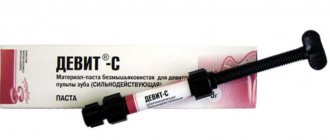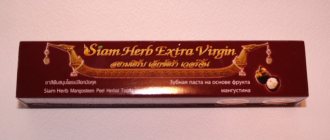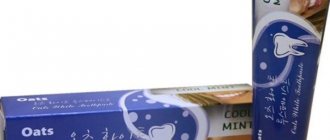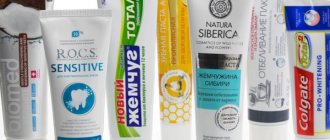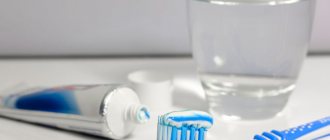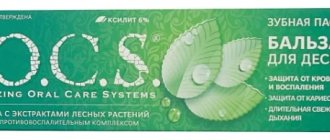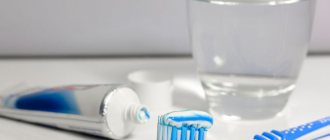Competent and thorough oral hygiene is an integral part of caring for your health and appearance. Agree, a beautiful, shining white smile immediately catches the eye and wins over your interlocutors. And if fresh breath and a great mood are added to snow-white teeth, communication will be guaranteed to be pleasant.
However, modern people are increasingly concerned about bad breath, dark plaque on the teeth, caries and various tissue inflammations. To prevent all these problems from affecting you, it is important to take effective care of your oral cavity by using antibacterial toothpaste.
In the beginning there was sand and chalk
Toothpaste and brush are everyday things with which our day begins and ends. However, they were once a real luxury. The ancient Egyptians were the first to think about oral hygiene and began to use sand, ash, ground stones and animal horns as a cleaning agent, and their own finger replaced the brush. In the 4th century BC. The great healer Hippocrates recommended using mixtures of pumice with the addition of wine vinegar, which are more gentle on tooth enamel, to prevent dental diseases. At the end of the 18th century, little had changed. For example, the British brushed their teeth with powders that included crushed brick, crushed bark and coal chips.
The prototype of modern toothpaste was invented by Americans in the 19th century. This time there were no stones or ash. Teeth cleaning products were a mixture of chalk powder, neutral soap and aromatic additives. It was only in 1873 that Colgate released the first toothpaste in glass jars, which replaced tubes two decades later. They were invented by dentist Washington Sheffield of New London. But Colgate beat the inventor by quickly registering a patent for itself. An interesting fact is that in Russia, most people at that time continued to brush their teeth with chalk-based powder, and only in the 50s it became possible to buy a familiar tube of toothpaste in stores.
What inflammations can bacteria cause?
Everyone knows that bacteria are the main cause of inflammatory processes in the oral cavity. Normally, we have aerobic microflora in our mouth, which takes part in the primary processes of food digestion, absorption of nutrients and vitamins.
But when foreign bacteria begin to displace beneficial bacteria and settle in their place, various diseases of the teeth and gums appear.
Caries is considered to be the most common dental problem. Almost everyone has encountered this disease. Caries appears as small faded spots on the enamel. These stains darken over time and the tooth begins to decay.
Common causes of caries are insufficient oral hygiene, improper, unbalanced diet, and sometimes oral trauma.
Superficial caries is accompanied by increased sensitivity of the enamel, deep caries is accompanied by the appearance of visible holes in hard tissues and more acute pain. Children often develop bottle caries due to prolonged use of pacifiers and pacifiers, as well as retention of food debris in the mouth after night feedings.
The consequence of untreated deep caries is most often pulpitis. The damage reaches the dentin, and then to the pulp chamber, which contains the neurovascular bundle. In rare cases, the pulp becomes inflamed due to infection carried through the bloodstream from other organs.
Pulpitis is characterized by severe pain, and sometimes by pus and fever.
Another common problem is a dental cyst or inflammatory process, which is characterized by the growth of tissue near the root. Most often, the cyst is provoked by pulpitis and periodontitis. The cyst is accompanied by swelling of the gums and severe pain.
Sometimes advanced pulpitis develops into periodontitis, inflammation of periodontal tissue, the structure that holds the roots of the teeth in the alveolus of the jaw. This complex disease provokes tooth mobility, purulent inflammation and even fever.
Other common oral diseases are:
- Periodontitis is an inflammation of the periodontium, which is manifested by bleeding gums and accumulation of pus in periodontal pockets.
- Periodontal disease is the loss of connection between the root and the jaw due to atrophy of the dental process of bone tissue. With periodontal disease, pus begins to accumulate in the periodontal pockets, the neck of the teeth is gradually exposed, which can provoke complete tooth loss.
The main cause of diseases of the teeth and gums, as a rule, is improper oral hygiene, ignoring antibacterial toothpastes and antibacterial rinses, and irregular teeth brushing. Sometimes diseases are provoked by infectious diseases, in which pathogenic bacteria penetrate into the dental tissues from the oral cavity, in which inflammation occurs, through cracks in the crowns or through the bloodstream from a diseased, infected organ.
Doctors include other causes of oral pathologies:
- poor nutrition and, accordingly, insufficient supply of nutrients to dental tissues;
- taking medications;
- excessive intake of certain elements into the body (for example, fluoride);
- metabolic disorders, hormonal shifts;
- reduced immunity;
- oral injuries;
- congenital anomalies of the dentition;
- hereditary predisposition to dental diseases;
- exposure to chemicals and radiation, working in hazardous industries or living in contaminated areas.
Best toothpaste
Which toothpaste is better? Definitely one that meets a person’s needs and suits his indications. Until recently, the main task of toothpaste was to help the brush clean teeth from plaque. Today, modern manufacturers of hygiene products have expanded its functionality and began to offer special medicinal toothpastes, both complex and for targeted solutions to specific problems. Today you can find tubes not only for the prevention of caries, but also for bleeding gums, against the formation of tartar, paste for implants or smoker’s plaque, for fresh breath or restoring the pH balance of the oral cavity, as well as for much more. But, in fact, all pastes are divided into several varieties, which we will consider.
Clinical researches
The products in the Asept line have proven clinical effectiveness and are therefore sold in pharmacies. For example, multiple clinical studies have proven that regular use of preventive toothpaste ASEPTA ACTIVE for a month can reduce bleeding gums by 60%, improve the overall condition of the oral cavity by 44% and reduce inflammation by 33%.
Sources:
- Report on determining/confirming the preventive properties of toothpaste “ASEPTA PLUS” GENTLE WHITENING” Author: doctor-researcher A.A. Leontyev, head Department of Preventive Dentistry, Doctor of Medical Sciences, Professor S.B. Ulitovsky First St. Petersburg State Medical University named after. acad. I.P. Pavlova, Department of Preventive Dentistry
- Clinical and laboratory assessment of the influence of domestic therapeutic and prophylactic toothpaste based on plant extracts on the condition of the oral cavity in patients with simple marginal gingivitis. Doctor of Medical Sciences, Professor Elovikova T.M.1, Candidate of Chemical Sciences, Associate Professor Ermishina E.Yu. 2, Doctor of Technical Sciences Associate Professor Belokonova N.A. 2 Department of Therapeutic Dentistry USMU1, Department of General Chemistry USMU2
- Report on the determination/confirmation of the preventive properties of personal oral hygiene products “ASEPTA PLUS” Remineralization doctor-researcher A.A. Leontyev, head Department of Preventive Dentistry, Doctor of Medical Sciences, Professor S.B. Ulitovsky First St. Petersburg State Medical University named after. acad. I.P. Pavlova, Department of Preventive Dentistry
- Clinical studies of antisensitive toothpaste “Asepta Sensitive” (A.A. Leontyev, O.V. Kalinina, S.B. Ulitovsky) A.A. LEONTIEV, dentist O.V. KALININA, dentist S.B. ULITOVSKY, Doctor of Medical Sciences, Prof. Department of Therapeutic Dentistry, St. Petersburg State Medical University named after. acad. I.P. Pavlova
Pastes for the prevention of dental caries
Toothpastes for the prevention of caries are recommended for increased susceptibility to the formation of caries bacteria, as well as as restorative therapy after teeth whitening. They saturate dental tissues with useful minerals, prevent the growth of carious bacteria, and also fight the formation of plaque. To strengthen teeth, fluoride compounds are added to such pastes. It is contained in such pastes as “Day and Night” Swiss Smile, Enzycal 950 CURAPROX, Mirafluor C Miradent, “Power of a Smile” Jason and others. Fluorine is an important microelement, since it is the one that participates in the metabolism of calcium, and, therefore, ensures its presence in the enamel. But it is worth remembering that it is extremely toxic, so its amount entering the body should not exceed the established norm. People living in areas with fluoride-saturated water (more than 1.2 mg/l) are advised to use fluoride-free toothpaste. You can find out about the fluoride content in the water in your area by calling the nearest Sanitary and Epidemiological Station.
Toothpaste
Theodent Classic
Mineral salts
Mineral salts and their complexes added to toothpastes have a beneficial effect on the oral mucosa, help improve blood circulation, dissolve mucus, and prevent the formation of soft plaque. Salts are able to maintain the acid-base balance, normalizing metabolic processes, alkalizing the oral cavity and, creating an optimal environment for enamel mineralization processes, stimulate salivation, thus ensuring the implementation of the protective and buffering functions of saliva. Some of the salt additives contain macro- and microelements that can be included in the hard tissues of the tooth. The high concentration of salts in pastes causes an increased outflow of tissue fluid from the inflamed gums, and also has some analgesic effect.
Toothpastes contain sea salt and table salt. Mineral waters rich in salts and brine from the Pomorie estuaries are used, which also improves the blood supply to periodontal tissues and their trophism. Sodium bicarbonate (baking soda) is a mild abrasive that neutralizes the acidic activity of bacteria.
Salt-containing toothpastes
indicated for significant formation or tendency to form non-mineralized dental plaque, chronic inflammatory diseases of the periodontium and oral mucosa, increased viscosity of saliva, hyposalivation.
Pastes against tooth sensitivity
There are special toothpastes for sensitive teeth. They contain potassium chloride, potassium citrate (Twin Lotus Recipe for Sensitive Teeth, Mirasensitive hap+) or strontium chloride. These substances “clog” the dentinal tubules and reduce hyperesthesia. They also saturate the tooth enamel with minerals, the deficiency of which is most often the cause of increased sensitivity of enamel and dentin. But the most progressive substance today is considered to be hydroxyapatite (Sensitivity Control Biorepair). Its crystals are similar in composition to tooth enamel, so they effectively combine with it, restoring the natural protection of teeth. Pastes for sensitive teeth should not contain a drop of chemical bleaches and, instead of coarse calcium carbonate, should contain gentle abrasive substances with a smaller particle diameter, for example, silicon oxide. Such pastes are recommended for hypersensitive teeth, as well as for use during and/or after teeth whitening procedures.
Sensitivity Control Biorepair toothpaste
Pastes for strengthening gums
Toothpastes aimed at preventing and reducing periodontal inflammatory processes reduce bleeding gums, help strengthen them, have an astringent effect, and also destroy harmful microbes. They most often contain antibacterial substances, for example with chlorhexidine, as in Curaprox ADS 712 paste, together with plant extracts that have an anti-inflammatory effect, such as edelweiss and echinacea in the SWISS SMILE vitamin herbal paste or witch hazel and calendula in the Plus Parodontgel BioRepair paste. Some of them also contain chlorophyll and vitamin E. All of these substances have a beneficial effect on gum tissue, accelerating the healing process and the formation of new cells. Such pastes are recommended for diseases of stomatitis, gingivitis and periodontitis.
Toothpaste Curasept ADS 712 CURAPROX
What is the effect of titanium dioxide on the body?
For a long time it was believed and is still believed at the official level that this compound is absolutely inert and does not linger in the body. Therefore, under the name “additive E171”, it is generously added both to hygiene products and food products - yoghurts, marshmallows, crab sticks, etc.
But a study by Chinese scientists suggests that titanium dioxide particles penetrate from the gastrointestinal tract into other organs and damage the liver and kidneys. And scientists from the USA discovered that this substance has a negative effect on the cells of the brain and nervous system, causing their diseases.
Toothpaste “Herbal Twin Lotus Original”, with herbs, 100 g, Twin Lotus
265 ₽
Dietary supplement NOT A MEDICINE
Pastes against bad breath
The action of toothpastes that help fight halitosis is aimed at restoring the normal balance of oral microflora, the disruption of which is usually accompanied by excessive proliferation of anaerobes. These substances emit volatile sulfur-containing products that have a pungent odor. Anti-bad breath pastes contain components that suppress pathogenic microflora and act on viruses. In addition, such pastes eliminate dry mouth syndrome, which can also cause halitosis. Antihalitic hygiene products are recommended for bad breath caused by microflora disturbances and dry mouth.
Enzymatic toothpaste gel
Jason Enzyme Brightening
Features of antibacterial agents
Pathogenic bacteria multiply in the oral cavity through the interaction of food debris with saliva. When caring for healthy teeth, daily hygiene using traditional toothpastes is sufficient. Specialized formulations are recommended by dentists when the following problems occur:
- gingivitis;
- periodontitis;
- caries.
Antibacterial products help cope with pathogenic microorganisms that cause the development of diseases. It has anti-inflammatory and antiseptic effects. Thanks to this, it promotes rapid wound healing and recovery after dental surgery.
To achieve a positive effect, antibacterial cleaning is not enough. Therefore, the active formula of toothpastes includes additional components for comprehensive oral care. Most often used in the composition:
- chlorine dioxide;
- propolis;
- triclosan;
- aloe extract;
- chlorhexidine;
- zinc;
- silver molecules;
- Eucalyptus oil.
Composition of toothpaste - which is better?
A dental hygienist can help you figure out which toothpaste is best for specific oral problems. When purchasing a product yourself, you need to pay attention to whether it contains substances potentially harmful to teeth. For example, coarse abrasive substances that negatively affect tooth enamel. These may be chalk or calcium carbonate, as well as aluminum oxides, which are prohibited in some countries. Nowadays, silicon dioxide is considered the best abrasive; it gently removes all dental plaque without having a negative effect on the enamel and gums. You can also find other safe abrasive substances in paste compositions—dicalcium phosphate or sodium metaphosphate.
You should be careful with toothpastes that contain triclosan or chlorhexidine. Brushing with such pastes may be necessary to treat inflammation in the gums or to eliminate bad breath. However, long-term use (more than 3 weeks) of paste with antibacterial substances can lead to disruption of the beneficial microflora of the oral cavity. If sodium lauryl sulfate is in one of the first places in the description of the composition (that is, its percentage is large), then it is also better not to buy such a paste. The fact is that this surfactant is responsible for foaming, but does not in any way affect the quality of cleaning. In addition, it has long been proven that even in small doses, sodium lauryl sulfate can negatively affect the body. This component is contained in all pastes from Blend-a-med, Colgate, Oral-B, Aquafresh, Karimed, Forest Balsam, some pastes from Lacalut, SPLAT, PresiDENT, and New Pearl.
How much does toothpaste cost and where to buy it?
The price of toothpaste varies from 50 to 1,000 rubles per tube, and sometimes can exceed this threshold. Some people think that expensive pastes are the best, others don’t see the difference in all the variety and buy the cheapest one. In both cases, the buyers are wrong. A high price does not always indicate the quality of a product, and buying cheap pastes is simply dangerous - they may turn out to be a fake or a product not manufactured in accordance with GOST. Where to buy toothpaste? This is best done in pharmacies and specialized stores, such as Startsmile Shop. You should not buy pasta in underground passages, at the market, on the train, or from “distributors.”
The choice of toothpaste determines many things - the appearance of teeth and gums, the condition of the enamel and its saturation with essential microelements. However, even the best toothpaste is not able to protect teeth from caries and gums from inflammation if cleaning is carried out quickly, poorly, incorrectly and irregularly.



